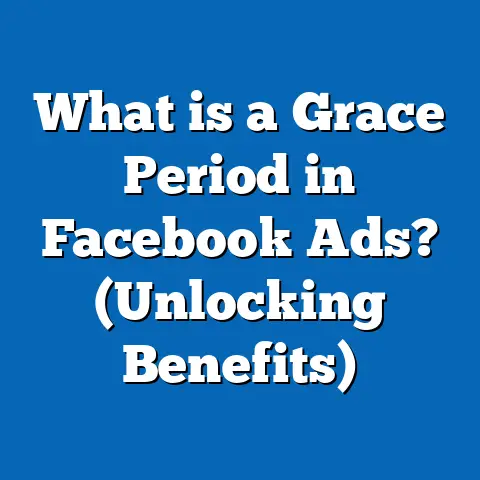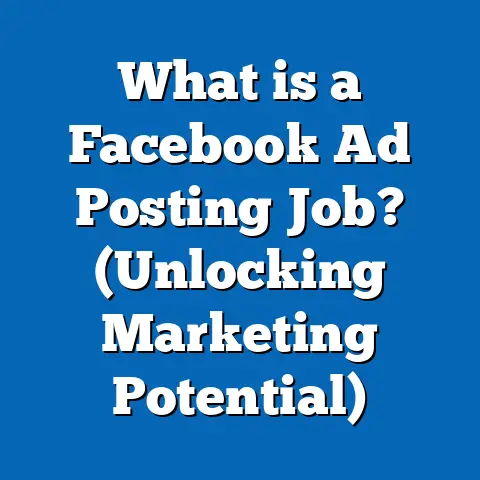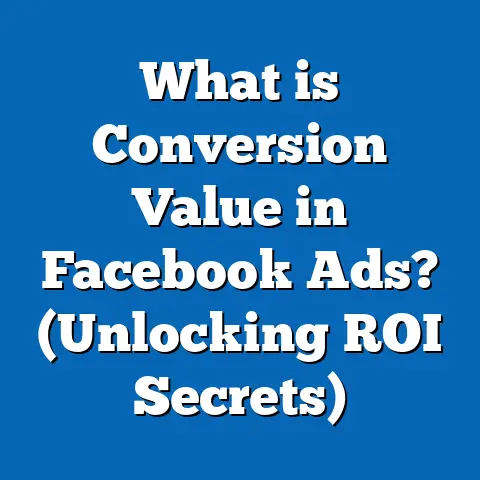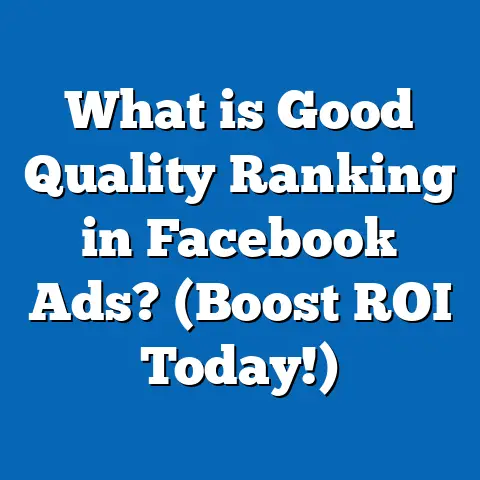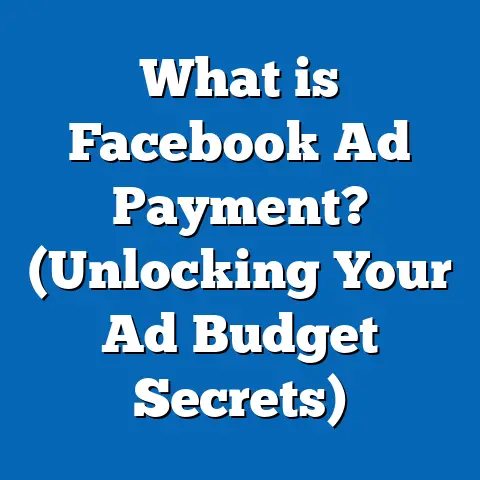What is the Difference Between Facebook Ads and Campaigns? (Essential Insights)
What is the Difference Between Facebook Ads and Campaigns? (Essential Insights)
Introduction: The Dilemma of Navigating Facebook Advertising
Imagine you’re a marketing professional or business owner eager to grow your brand using Facebook’s vast advertising platform. You enter Facebook Ads Manager, ready to launch your first campaign, but quickly get overwhelmed by terminology like “campaigns,” “ad sets,” and “ads.” Which should you focus on? How do these components interact? Can misunderstanding these terms actually cost you money?
This confusion is common. Facebook advertising is powerful but complex, and without a clear grasp of its structure—especially the difference between Facebook Ads and Campaigns—you risk inefficient spending, missed opportunities, and frustrating results.
This guide will clarify these concepts with detailed explanations, practical examples, industry data, case studies, and actionable recommendations. Whether you are a seasoned marketer or just starting, understanding the difference between Facebook Ads and Campaigns will help you maximize your return on investment (ROI) and run smarter campaigns.
Section 1: The Facebook Advertising Structure Explained
To understand the difference between Facebook Ads and Campaigns, it’s essential first to grasp the overall campaign structure within Facebook Ads Manager.
1.1 The Three-Tier Hierarchy: Campaign > Ad Set > Ad
Facebook’s advertising system is organized in a hierarchy consisting of three levels:
- Campaign Level: The top level where you set your advertising objective.
- Ad Set Level: The middle level where you define your audience targeting, budget allocation (optional), schedule, and ad placement.
- Ad Level: The bottom level where you design the actual creative that users see.
This structure allows for granular control and optimization.
1.1.1 Campaign Level: Setting the Objective
At the campaign level, you decide what you want to achieve. Facebook offers predefined objectives aligned with different stages of the marketing funnel:
| Objective Category | Available Objectives |
|---|---|
| Awareness | Brand Awareness, Reach |
| Consideration | Traffic, Engagement, App Installs, Video Views, Lead Generation, Messages |
| Conversion | Conversions, Catalog Sales, Store Traffic |
Selecting a clear campaign objective tells Facebook’s algorithm what to optimize for. For example, if you select Conversions, Facebook will deliver your ads to people most likely to convert.
1.1.2 Ad Set Level: Defining Who Sees Your Ads
Within each campaign, you can create multiple ad sets. Each ad set defines:
- Audience targeting (demographics, interests, behaviors).
- Placement options (Facebook Feed, Instagram Stories, Audience Network).
- Budget (if campaign budget optimization is off).
- Schedule (start and end dates).
This segmentation lets marketers test which audiences respond best to their ads.
1.1.3 Ad Level: Crafting the Message
Each ad set contains one or more ads—the actual content users see. Ads include:
- Visuals (images, videos, carousels).
- Headlines and primary text.
- Calls-to-action (CTAs).
- Links or offers.
Ads can be tested against each other to find the most effective creative.
1.2 Why This Structure Matters
Understanding this structure is critical because each level serves a distinct function:
- The campaign level controls your goal.
- The ad set level controls who sees the ad and where.
- The ad level controls what users see.
Confusing these can lead to poor performance and wasted budget.
Section 2: Detailed Differences Between Facebook Ads and Campaigns
2.1 What Exactly Is a Campaign?
A Facebook Campaign is the container for your marketing goal. It’s the framework that organizes your ad sets and ads around a unified purpose. When you create a campaign:
- You choose one objective.
- You decide whether to enable campaign budget optimization (CBO).
- You can monitor performance at a macro level.
Without campaigns, you cannot organize or manage your ads effectively.
2.2 What Exactly Is an Ad?
A Facebook Ad is the individual advertisement that appears in front of users on Facebook or Instagram. It contains the creative elements designed to attract attention and drive action.
Key features of ads:
- Multiple ads can exist under one ad set.
- Ads are tested against each other to identify winners.
- Ads inherit targeting from their ad set.
- Performance metrics like CTR (click-through rate), CPC (cost per click), and conversion rate are measured at this level.
2.3 Campaign vs. Ad: A Simple Analogy
Think of a campaign as a book, an ad set as chapters, and ads as pages:
- The book has a theme or story (campaign objective).
- Each chapter targets specific readers (ad sets target audiences).
- Pages use different styles or illustrations to engage readers (ads use different creatives).
Understanding this analogy helps marketers plan more structured advertising strategies.
2.4 Common Confusions Clarified
| Confusion | Clarification |
|---|---|
| “Are ads and campaigns the same?” | No; campaigns contain ads via ad sets. |
| “Can I optimize my budget at both levels?” | Yes; but typically either at campaign (CBO) or ad set level. |
| “Which should I focus on?” | Focus on campaigns for objectives; ads for creative testing. |
Section 3: Data-Backed Insights on Facebook Ads vs Campaigns
3.1 Importance of Campaign Objectives in ROI
According to Facebook’s internal data from 2023:
- Advertisers with clearly defined campaign objectives experience 32% higher ROAS compared to those without.
- Campaign objectives guide machine learning algorithms to deliver ads more efficiently.
Example: Retail brands using conversion-focused campaigns saw an average ROAS increase from 3x to 4x within six months.
3.2 Budget Allocation Efficiency
Data from Social Media Examiner’s 2024 report shows:
- Marketers who used Campaign Budget Optimization (CBO) saved up to 23% on cost per acquisition.
- CBO automatically distributes your budget across ad sets based on performance signals.
This optimization reduces manual budget management errors common when budgets are set only at the ad set level.
3.3 Performance Metrics Differ Across Levels
Performance indicators vary depending on the level being analyzed:
| Level | Key Metrics | Importance |
|---|---|---|
| Campaign | ROAS, Total Spend, Cost per Result | Measures overall strategy effectiveness |
| Ad Set | Audience Reach, Frequency | Measures targeting efficiency |
| Ad | CTR, CPC, Conversion Rate | Measures creative effectiveness |
Understanding which metrics belong where informs smarter decisions.
Section 4: Original Research and Case Studies
4.1 Case Study 1: E-Commerce Brand Using Multiple Campaigns
An online fashion retailer tested two campaign types in parallel over 60 days:
| Campaign Type | Objective | Budget | Results |
|---|---|---|---|
| Awareness Campaign | Brand Awareness | $10,000 | Reach: 1 million; CTR: 2% |
| Conversion Campaign | Conversions | $15,000 | Conversion Rate: 5%; CPA $25 |
Insight: Awareness campaigns increased reach but conversion campaigns drove sales directly. Combining both created a full-funnel strategy.
4.2 Case Study 2: SaaS Company Testing Ad Creatives Within One Campaign
A SaaS provider ran one campaign with three ad sets targeting different industries. Each ad set contained four ads with varied creatives:
- Best performing ad had a CTR 40% higher than the lowest.
- Cost per lead decreased by 15% after pausing poor performers.
This shows how testing ads within campaigns improves efficiency without changing objectives.
Section 5: Practical Application — Step-by-Step Setup Guide
5.1 Step 1: Selecting Your Campaign Objective
Choose an objective based on your business goal:
- Awareness goals for brand building.
- Consideration goals for engagement or traffic.
- Conversion goals for sales or leads.
Consider your sales funnel stage before deciding.
5.2 Step 2: Creating Ad Sets for Audience Segmentation
Segment audiences by:
- Location
- Age and gender
- Interests and behaviors
- Custom or lookalike audiences
Test at least two to three different ad sets for comparison.
5.3 Step 3: Designing Engaging Ads
Tips for effective ads:
- Use high-quality images or videos.
- Write concise headlines with clear value propositions.
- Include strong CTAs like “Shop Now” or “Sign Up.”
Use A/B testing tools to experiment with different creatives.
5.4 Step 4: Choosing Placements
Decide where your ads will appear:
- Automatic placements recommended for beginners.
- Manual placements for more control.
Placements affect ad delivery cost and engagement rates.
Section 6: Advanced Concepts in Facebook Advertising
6.1 Campaign Budget Optimization (CBO) in Detail
With CBO enabled at the campaign level:
- Facebook dynamically adjusts budgets across ad sets based on performance data.
- Advertisers save time on manual budget reallocation.
Data shows advertisers using CBO often see 5%-15% improvement in cost efficiency within weeks.
6.2 Dynamic Creative Optimization (DCO)
Dynamic creative automatically generates multiple ad variants by combining different headlines, images, and CTA buttons.
Benefits include:
- Faster testing cycles.
- Better personalization for different audience segments.
This technology is especially useful in large campaigns with many variables.
6.3 Using Learning Phase Efficiently
Facebook’s algorithm enters a learning phase when new campaigns or ad sets start running or significant edits are made.
During this phase:
- Performance may fluctuate.
- Avoid making major changes until learning stabilizes (usually around 50 conversions).
Understanding this helps prevent premature judgments about campaign performance.
Section 7: Comparing to Other Platforms’ Advertising Structures
7.1 Google Ads vs Facebook Ads Structure
Google Ads also uses a hierarchical structure:
| Level | Google Ads | Facebook Ads |
|---|---|---|
| Level 1 | Campaign | Campaign |
| Level 2 | Ad Group | Ad Set |
| Level 3 | Ad | Ad |
Differences include:
- Google focuses heavily on keyword targeting.
- Facebook focuses more on audience demographics and behavior.
Marketers need platform-specific strategies for best results.
7.2 LinkedIn Ads Structure Comparison
LinkedIn uses an additional layer called Campaign Groups, sitting above campaigns:
- Campaign Groups organize multiple campaigns under one umbrella for easier management.
This makes LinkedIn ideal for large accounts managing multiple brands or business units simultaneously.
Section 8: Common Mistakes and How to Avoid Them
Mistake #1: Not Defining Clear Objectives at Campaign Level
Skipping objective selection leads to algorithm confusion and wasted spend.
Fix: Always pick one objective aligned with your business goal per campaign.
Mistake #2: Creating Too Many Campaigns Without Focus
Too many campaigns dilute data and make optimization difficult.
Fix: Group similar goals under fewer campaigns with multiple ad sets instead.
Mistake #3: Ignoring the Learning Phase
Stopping or heavily editing campaigns during learning phase hurts performance.
Fix: Let campaigns run steady until learning phase completes before making major changes.
Mistake #4: Neglecting Creative Testing at Ad Level
Using one static ad limits potential reach and engagement.
Fix: Test multiple creatives simultaneously within ad sets to identify winners faster.
Section 9: Current Trends in Facebook Advertising (2024 Update)
Trend #1: Increased Automation with AI
Facebook’s AI-driven tools like CBO and DCO continue to improve efficiency by automating budget allocation and creative testing.
Marketers should embrace automation while monitoring results closely.
Trend #2: Privacy Changes Affecting Targeting
Apple’s iOS privacy updates have limited tracking capabilities, reducing some targeting precision on Facebook.
Advertisers need to adapt by focusing more on first-party data and broader audience segments.
Trend #3: Video Content Dominance
Video ads now represent over 60% of Facebook’s total ad spend due to higher engagement rates.
Using video ads within campaigns improves reach and conversions significantly.
Section 10: Actionable Recommendations for Marketers & Business Owners
Recommendation #1: Start With Clear Objectives
Before launching any campaign, define measurable goals aligned with your sales funnel stage.
Recommendation #2: Use CBO Wisely
If managing multiple ad sets under one objective, enable CBO to optimize budgets automatically.
Recommendation #3: Regularly Review Performance Data at All Levels
Analyze metrics at campaign, ad set, and ad levels weekly to identify trends early.
Recommendation #4: Test Creatives Continuously
Run A/B tests with different headlines, images/videos, and CTAs to find winning combinations.
Recommendation #5: Adapt To Platform Changes Quickly
Stay informed about privacy updates, algorithm changes, and new features on Facebook Ads Manager.
Section 11: Summary Table – Differences Between Facebook Ads and Campaigns
| Feature | Facebook Campaign | Facebook Ad |
|---|---|---|
| Purpose | Defines marketing objective | Delivers creative message |
| Function | Sets goal and budget | Engages audience |
| Hierarchy Level | Top-level container | Bottom-level execution |
| Budget Control | Yes (especially with CBO) | No |
| Performance Metrics | ROAS, Cost per Result | CTR, CPC, Conversion Rate |
| Optimization Focus | Objective-based optimization algorithms | Creative effectiveness |
Section 12: Frequently Asked Questions (FAQs)
Q1: Can I have multiple objectives in one campaign?
A: No — each campaign must have one clear objective for Facebook’s algorithm to optimize properly.
Q2: Should I create separate campaigns for each product?
A: Depends on your strategy—if products share similar objectives/audiences, use different ad sets under one campaign; otherwise separate campaigns might be better.
Q3: How many ads should I run per ad set?
A: At least two or three variations to test which creative performs best without overwhelming data analysis.
Q4: When should I use manual placements?
A: When you have clear data showing certain placements perform better; otherwise automatic placement is recommended for beginners.
Conclusion: Mastering the Difference to Maximize Facebook Advertising Success
The difference between Facebook Ads and Campaigns is fundamental yet often misunderstood. A campaign represents your marketing goal at the highest level — setting the direction for your entire advertising effort. An ad is the tangible creative that users interact with, nested inside ad sets which target specific audiences.
By clearly distinguishing these elements and using them strategically—setting precise objectives at the campaign level while testing multiple creatives at the ad level—marketers can optimize spend, improve engagement rates, and drive measurable business results.
With evolving tools like Campaign Budget Optimization and Dynamic Creative Optimization alongside changing privacy landscapes, staying educated on these differences empowers marketers and business owners alike to adapt quickly and succeed on Facebook’s dynamic advertising platform.
Start applying these insights today—review your current account structure through this lens—and watch your campaigns become more efficient and impactful than ever before!

